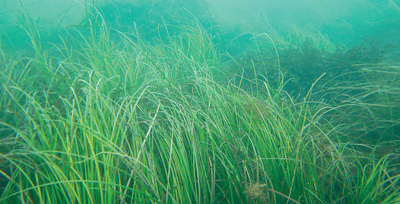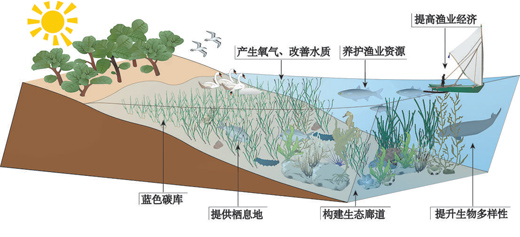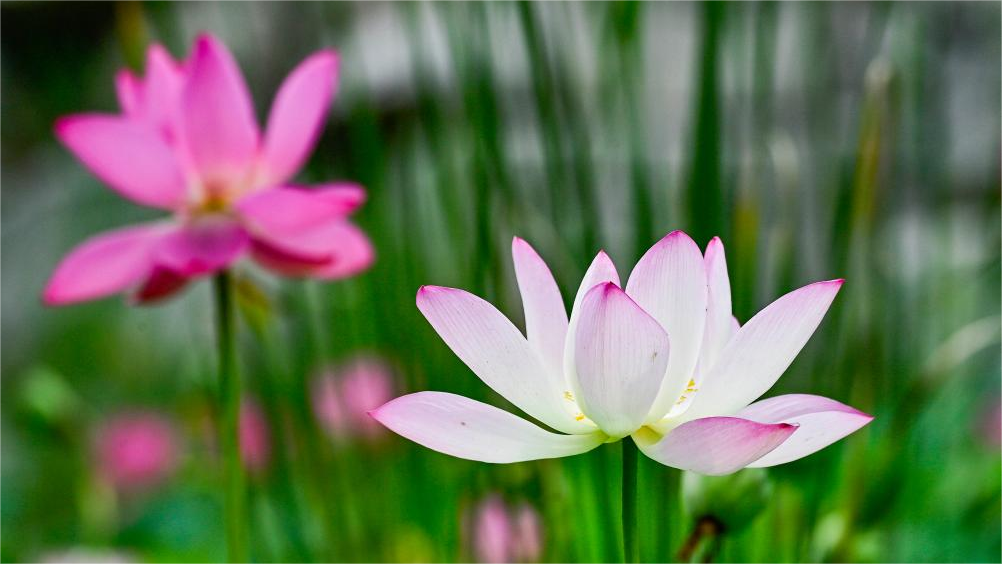Chinese researchers vow to restore seagrass beds

Photo shows seagrass in a sea area of Swan Lake in Rongcheng, a county-level city of Weihai in east China's Shandong Province. (Photo courtesy of Ocean University of China)
Carrying an oxygen tank and wearing a diving suit, Zhang Peidong, a professor at the Fisheries College of Ocean University of China (OUC), dived into a sea area of Swan Lake in Rongcheng, a county-level city of Weihai in east China's Shandong Province, to check on the growth of seagrass.
Zhang saw an underwater "grassland" thriving with sea snails, crabs, shellfish and other marine animals there. The underwater "grassland" is the seafloor covered with seagrass, also known as seagrass beds.
Zhang and his teammates have dedicated 16 years to "planting" seagrass and protecting the marine environment.
In winter of 2008, Zhang and his teammates came to Swan Lake, a wintering place for whooper swans, for research.
They found that the number of overwintering whooper swans plummeted in the lake due to the significant decrease in eelgrass, a type of seagrass that serves as a major source of food for the birds and plays a vital role in protecting the local marine ecosystem, as a result of human activities.
According to their research, a large number of seagrass beds disappeared nationwide back then. The submarine ecological crisis drove them to lead students to "plant" seagrass and explore ways to restore the seagrass bed ecosystem.
"To 'plant' seagrass, we needed to conduct extensive surveys and experiments beforehand to understand the growth rules of seagrass and develop targeted measures," Zhang said, adding that this process alone took them 10 years.
In the same year, the Mashan Group, a Weihai-based company committed to marine ecological restoration, provided various support including workshops and office space by Swan Lake for the research team of the OUC. In 2022, the university and the company jointly established a science and technology backyard there.
After a long period of hard work, the research team developed an artificial cultivation technology of eelgrass seedlings after figuring out the growth rules and the best timing to pick seeds. Researchers collect eelgrass seeds underwater, artificially cultivate seedlings and then transplant them in the sea.
They have managed to shorten the germination stage of eelgrass seeds from over 80 days in the natural environment to about just 10 days, according to Li Wentao, a member of the research team.
The research team has developed a relatively complete ecological restoration system for seagrass beds in temperate zones.
In 2022, the technical specification for seagrass bed construction, compiled under the leadership of the OUC's research team, was approved by the Ministry of Agriculture and Rural Affairs. This is China's first industry standard for seagrass bed ecological restoration technologies, laying a technical foundation for standardizing and guaranteeing seagrass bed ecological restoration projects in the country.
The research team has also developed several sets of equipment with independent intellectual property rights, significantly improving the planting efficiency.
So far, the OUC's research team has participated in more than 10 submarine ecological restoration projects in China, restoring and maintaining over 20,000 mu (1,333 hectares) of seagrass beds in the Yellow Sea and Bohai Sea. Over 40 percent of Swan Lake's seagrass beds have been restored, attracting up to 8,000 whooper swans to the area to spend winter every year.
"In the future, we aim to combine seagrass bed ecological restoration with carbon sequestration, green marine ranches, high-value ecological products, and tourism to achieve both ecological and economic benefits," Zhang said.

Photo shows a simulation image of the seagrass bed ecosystem. (Photo courtesy of Ocean University of China)
Photos
Related Stories
- Top Chinese physicist calls for more investment in basic research planning
- Construction of China's first domestic medical isotope test reactor starts
- Chinese, US researchers jointly develop new type of stable semiconductor graphene with 10 times higher performance than silicon
- Influence of nation's research seen on rise
- Researchers bid to unlock mystery of shrinking mountain peaks
Copyright © 2024 People's Daily Online. All Rights Reserved.









